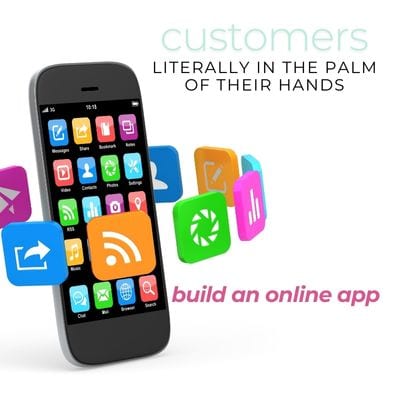Discover How to Build or Start an Online Business
Today I want to help you build or start an online business or take your off-line business, perhaps your services based business online to new heights.
Here are some of the ideas I have in store for you:
 Discover the essential steps to quickly and effectively start your online business with minimal hassle and maximum success.
Discover the essential steps to quickly and effectively start your online business with minimal hassle and maximum success.- Unlock new revenue channels with insights and strategies that maximize your profitability in the digital marketplace.
- Learn expert secrets and strategies that set you on the fast track to a thriving online business.
- Turn your vision into reality using actionable tactics that ensure a successful launch and sustainable growth.
- Equip yourself with beginner-friendly strategies and tools to launch your online business and achieve early wins in the digital world.
The digital age has opened many opportunities for entrepreneurs and service-based businesses to start online businesses. Understanding the types of online businesses is crucial before diving into market research and business planning. Here’s a breakdown of some popular online business models to help you choose what best suits your skills and interests.
And if you are a life coach, health and wellness coach, business coach, health practitioner, or one-on-one service provider, this applies to you. I realized this in my business. One-on-one services limit my time and financial potential, so I decided to pivot and leverage my marketing skills by developing new revenue streams requiring little time for long-term rewards and 24/7 cash flow.
The following list of online business models focuses on the ability to leverage time and expertise:
Affiliate Marketing
Affiliate marketing involves promoting other company’s products or services and earning a commission for every sale made through your referral link. This business model works well for bloggers, influencers, or websites with substantial traffic. Success in affiliate marketing hinges on selecting the right partners and providing genuine, relevant content.
Recommended Resources & Tools:
Discover John Crestani’s Super Affiliate System
Digital Products
Selling digital products is another profitable online business model. This includes downloadable content like e-books, online courses, software, music, and graphics. These products don’t require physical inventory, making overhead costs minimal. Successful digital product businesses offer valuable and high-quality content that meets the needs of their target audience.
Recommended Resources & Tools:
- Sqribbler– Creates AMAZING eBooks & Reports In 5 MINUTES Without Typing Any Words! For More Credibility, Leads, Sales & Raving Fans Today! Become An Author, Educate, Or Make Info Products In A Flash. No Design, Technical Or Writing Skills Required. Get started today!
- Build Your Online Courses Business on Teachable. Get Started Today!
- Discover LearnWorlds: The #1 AI-powered LMS built for course creators…From digital products to marketing and selling tools, get everything you need to build a profitable business, all in one scalable platform.
Subscription Services
Subscription services offer products or content regularly, such as monthly boxes of curated goods, group coaching, premium content, or software as a service (SaaS). This model ensures a steady income stream and allows for building a loyal customer base. However, consistent value delivery is required to discourage cancellations.
Recommended Resources & Tools:
Turn your coaching business into a revenue-generating app on Pssion.io. Start here.
Online Group Coaching and Consulting
Online group coaching and consulting leverage personal expertise to help others achieve their goals. This can include business coaching, life coaching, health and wellness coaching, fitness training, or financial consulting. Building authority in a specific field and providing tangible client results are crucial to success in this business model.
Recommended Resources & Tools:
Turn your coaching business into a revenue-generating app on Passion.io. Start here.
Build Your Dream Community:Radha Agrawal has built thriving global communities exceeding 500,000 members, such as Daybreaker. In this program, she’ll guide you through creating your own community of any size around your work, mission, or idea. Get started today!
Blogs and Content Sites
Blogs and content sites generate revenue through advertisements, sponsored content, or membership fees. This model requires creating high-quality, engaging content that attracts a regular audience. Monetization depends on traffic volume, but successful content sites often have multiple income streams, including affiliate marketing and digital products.
E-commerce Stores
E-commerce stores are one of the most common online business models. They involve selling physical products through an online platform. Business owners can create branded websites or use marketplaces like Amazon, eBay, or Etsy. Successful e-commerce stores focus on niche products and provide exceptional customer experiences.
Dropshipping
Dropshipping is a type of e-commerce where you don’t need to manage inventory. Instead, you receive customer orders and pass them to a third-party supplier who ships the products directly to the customers. This model reduces the risk and cost of keeping stock but may involve lower profit margins.
Understanding these various types of online businesses will help you identify the model that aligns with your passion and skills. This foundational knowledge sets the stage for conducting comprehensive market research and developing a robust business plan.
Next, we’ll delve into how to conduct market research and identify profitable niches, ensuring your business idea has the potential for success.
Affiliate Disclosure
We believe in the honesty of relationships and trust. In the spirit of full disclosure, we’d like to let you in on something. Some of the links we provide are “affiliate links”. This means if you decide to make a purchase, we might earn a commission at no additional cost to you. Rest assured, we recommend products that we truly believe can add value to your business ventures. It’s just one of the ways to keep the lights on, but always in a way that respects and honors the astute entrepreneurs we serve.

1. Market Research and Business Planning
Starting an Online Business? Identifying Profitable Niches and Market Gaps is Essential
Embarking on your journey to creating a profitable online business begins with identifying a niche that interests you and is also viable and profitable. A niche refers to a specific market segment that you can target with your products or services. Here’s how you can identify such profitable niches:
- Personal Interests and Skills: Start by considering areas you are passionate about. What are your hobbies or skills? Being knowledgeable about your niche will keep you motivated and more credible.
- Market Demand: Use tools like Google Trends and keyword research tools to analyze what people are searching for online. Look for trends that show consistent or growing interest over time.
- Competitor Research: Studying your competition can provide insights into what works and what doesn’t. Tools like Ubersuggest, SEMrush and Moz can help you understand the keywords your competitors rank for and the content they produce.
- Identify Gaps: While examining your competition, identify areas that are missing or underserved needs within the niche. Addressing these gaps can give you a competitive edge.
- Validate Your Idea: Before fully committing, validate your niche by gathering feedback. Use surveys, forums, and social media to ask potential customers about their needs and pain points.
Analyzing Competition and Target Audience Demographics
Understanding both your competition and your target audience is crucial to carving out your space in the market.
Analyzing Competition
- Identify Key Competitors: Find out who your main competitors are by searching for your niche’s relevant keywords and noting the top-ranking websites and online businesses.
- Evaluate Their Offerings: Look at your competitors’ products or services. Analyze what makes them successful and what they lack.
- Check Their Marketing Strategies: Understand their marketing tactics, including SEO, social media, email marketing, and paid advertisements. Tools like BuzzSumo can show you their most shared content.
- Customer Reviews: Read the reviews and testimonials on your competitors’ websites and social media. This can provide insights into what their customers love and what they complain about, revealing opportunities for you.
Best Tools for Uncovering a Profitable Niche
If you are building or starting an online business doesn’t it make sense to turn to the world’s largest search engine? Let Google tell you what people are looking for online!
Let me explain.
SEO keyword research tools are exceptional for uncovering niche or underserved markets. These tools, such as Google Keyword Planner, SEMrush, Moz, and Ubersuggest, provide invaluable insights into what potential customers are searching for online. By analyzing search volume, competition, and related keywords, you can identify trends and gaps in the market that may not be immediately obvious.
The most widely used search engine globally, Google offers a wealth of data through its tools. Google Trends, for instance, allows you to track the popularity of specific search terms over time, helping you understand seasonal trends and emerging interests. This information is crucial for identifying profitable niches and ensuring your business idea aligns with current market demands.
Moreover, these tools help you understand the competitive landscape by revealing which keywords your competitors rank for and the content they produce. This knowledge enables you to craft a strategy that differentiates your offerings and targets unmet needs within your chosen niche.
In essence, leveraging SEO and content development tools for market research empowers you to make informed decisions, reducing the risk of entering an oversaturated market and increasing the likelihood of success for your online business.
Target Audience Demographics
- Define Your Ideal Customer: Create a detailed profile of your ideal customer, considering factors like age, gender, income level, education, and geographical location.
- Understand Their Behavior: Determine where your target audience spends their time online. Are they more likely to be on Instagram, Facebook, or Linked In? Knowing this helps tailor your marketing efforts.
- Analyze Psychographics: Look beyond demographics to understand their interests, values, and lifestyle. This will help you create more personalized and engaging content.
- Utilize Analytics: Use tools like Google Analytics to gather data about your audience’s behavior on your website. This includes how they found your site, what pages they visited, and how long they stayed.
You set a solid foundation for a successful online business by thoroughly researching your market and planning accordingly. This diligent approach will also give you the insights needed to develop a sustainable business model and revenue streams in the next stage of your journey.

2. Develop a Business Plan for Your Online Business Startup
Once you’ve identified a profitable niche for starting an online business and thoroughly analyzed your competition and target demographics, it’s time to develop a solid business plan. A strong business plan sets the groundwork for your online venture and helps you focus on your goals, strategy, and future growth.
Defining Your Business Model
Creating a sustainable online business model is critical to your success. Your business model should clearly outline how your online business will generate revenue and maintain profitability over time. Different online businesses require distinct approaches, so selecting one that aligns with your niche and expertise is essential.
Typical business models for online businesses include:
- E-commerce – Selling physical or digital products directly through an online store.
- Subscription Services – Offering products or services regularly, such as monthly subscriptions.
- Affiliate Marketing – Promoting third-party products or services and earning a commission on sales.
- Freelancing and Consulting – Providing professional services directly to clients on a project or retainer basis.
- Online Coaching Apps – creating an online app when building an online business is a pioneering approach to online marketing.
When choosing your business model, consider your resources, skills, market demand, and competition to ensure it aligns with your overall vision.
Establishing Revenue Streams
A successful online business typically relies on multiple revenue streams to ensure financial stability. Diversifying income sources can also help mitigate risks associated with market trends or customer behavior changes. Here are some typical revenue streams to consider:
- Direct Sales – Selling your products or services directly to consumers through your website or online app.
- Subscription Fees – Offering premium memberships, courses, or exclusive content for a recurring fee.
- Advertising – Generating income through sponsored content, pay-per-click advertising, or affiliate partnerships.
- Upselling and Cross-Selling – Encouraging customers to purchase additional products or services related to their initial purchase.
Integrating multiple revenue streams creates a more resilient business model less susceptible to fluctuations in any single income source.
Evaluating and Adjusting Your Plan
Developing a business plan isn’t a one-time task; it requires regular evaluation and adjustments. As your online business grows, you’ll gain new insights into what works and what doesn’t. Make time to review key performance indicators (KPIs), customer feedback, and market trends. Based on this data, refine your strategies to ensure continued growth and profitability.
Remember, a well-crafted business plan is your roadmap to success in starting an online business. It guides your day-to-day operations and provides a clear vision of your long-term goals.
As you move forward, building a strong personal brand will further enhance your business’s reputation and attract a loyal customer base.
A professional program for the person seeking a better network, stronger people skills, and an upper hand in work and in life.
What if you could reap all the rewards of entrepreneurial success – without any of the drawbacks? Most people become entrepreneurs for similar reasons, from money and time freedom to achieving a personal goal or mission. Yet the opposite often happens, as challenges like crippling anxiety, overwhelming workloads, and financial uncertainty twist the entrepreneurial dream into an entrepreneurial nightmare. And so it’s no surprise that 50% of entrepreneurs shut down their businesses within five years or less -While much of the remaining 50% often get stuck in an endless cycle of stress and struggle.
But does entrepreneurship really need to come with this heavy price?
Imagine owning a business that doesn’t shackle you, but instead sets you free
Become a Mindvalley Member and unlock access to Business Freedom Blueprint with Eric Emeades + Mindvalley’s complete curriculum of 100+ transformational programs for as low as $1 a day.

3. Build a Personal Brand- Set Yourself Apart in an Ocean of Online Businesses
Building a personal brand is critical to establishing your presence in the digital marketplace. It’s about defining who you are, what you stand for, and how you communicate that to your audience. A strong personal brand helps differentiate you from competitors and builds trust with potential customers.
Define Your Brand Identity Before Starting Any Online Business
Start by clearly defining your brand identity. This includes understanding your values, strengths, and what makes you unique. Think about the following:
- Your Mission: What do you aim to achieve with your business? How do you intend to impact your customers and the world?
- Your Vision: Where do you see your business in the future? Visualizing your end goal helps in shaping your brand journey.
- Core Values: Identify the principles that will guide your business decisions and how you interact with customers.
Craft Your Brand Message
Once you have a clear vision of your brand identity, it’s time to craft your brand message. This message should resonate with your target audience and differentiate you from your competitors. Your brand messages in building an on line business should be:
- Clear and Concise: Avoid jargon and complex language. Your message should be easy to understand and remember.
- Authentic: Stay true to your values and personality. Authenticity builds trust.
- Consistent: Ensure that your message is consistent across all platforms, whether it’s your website, social media, or marketing materials.
Build a magnetic personal brand that multiplies your income, impact, and influence
Join Mind Valley’s Gerard Adams in an 18-day program that unmasks the real you and transforms your business or career through the power of your unique personality and presence.
Develop Your Visual Identity
Your visual identity is how your audience visually perceives your brand. This includes your logo, color scheme, typography, and overall design aesthetics. Keep these in mind:
- Professional Design: Invest in professional design services if possible. A polished look can make a significant difference in how your brand is perceived.
- Consistency: Use the same visual elements across all your marketing channels to create a cohesive and recognizable brand.
Establish an Online Presence
To build and maintain your brand, a robust online presence is essential. This includes:
- Creating a Professional Website: Your website is your online hub. It should be user-friendly, visually appealing, and reflective of your brand identity.
- Active Social Media Profiles: Select the platforms that best reach your audience and update your profiles with consistent, engaging content.
- Blog and Content Creation: Share your expertise through blogs, articles, and other content forms. This not only helps in establishing authority but also drives traffic to your site.
Engage with Your Audience
Engagement is key to building a strong personal brand. Regularly interact with your audience through:
- Social Media: Respond to comments and messages promptly. Engage with your audience by asking questions, sharing stories, and showing appreciation.
- Email Newsletters: Regularly communicate with your subscribers through valuable and informative newsletters.
- Community Involvement: Participate in online communities, forums, and groups related to your niche. This helps in expanding your reach and building relationships.
A well-established personal brand will lay a solid foundation for your business’s growth and success. You can create a trusted and memorable presence in the online marketplace with a clear brand identity, consistent messaging, and active engagement. Focusing on these elements ensures that your brand stands out and resonates with your target audience.
As you build an online business and your personal brand, your next step will be solidifying your online presence, starting with choosing and registering a memorable domain name.
Learn how to make your brand unstoppable, so you attract customers and revenue with ease
Jeffrey Perlman is the Brand Architect behind Zumba and Mindvalley. In this program, he shows you how to build your own through a proven system that transcends conventional branding wisdom and transforms any brand into a game-changer

4. Build Your Online Presence Map Out Your Channels
Creating an online presence is essential for building an online business. It’s not just about having a website; you need to ensure that your brand stands out and can be easily found by your target audience. Here’s how to get started:
Choosing and Registering a Memorable Domain Name
Your domain name is your digital address. Choosing a memorable domain name helps people find and remember your business easily. Here are some tips:
- Keep it Short and Simple: A short domain name is easier to remember and type. Aim for one that reflects your business name or keywords related to your niche.
- Avoid Numbers and Hyphens: Numbers and hyphens can cause confusion and make your domain harder to communicate verbally. Stick to letters only if possible.
- Choose the Right Extension: While “.com” is the most popular and trusted, other extensions like “.net,” “.org,” or niche-specific ones like “.shop” can also be effective.
- Check Availability and Trademarks: Before finalizing, check that the domain name isn’t already used or trademarked by another entity.
Register your domain through reputable registrars like GoDaddy, Namecheap, or Google Domains to secure it for future use.
Selecting the Right E-Commerce Platform or Website Builder
Your e-commerce platform or website builder is the foundation of your online store. It determines the functionality, flexibility, and scalability of your site. Consider the following factors:
- Ease of Use: Platforms like Shopify, BigCommerce and WooCommerce are user-friendly and don’t require extensive technical knowledge.
- Customization Options: Make sure the platform allows customization to match your brand identity. WordPress with WooCommerce or Wix offers extensive customization capabilities.
- Scalability: Choose a platform that can grow with your business. BigCommerce, for example, is excellent for large-scale operations.
- Integrated Features: Look for platforms like WordPress or Squarespace with built-in features like SEO tools, marketing integrations, and secure payment gateways to streamline your operations.
Evaluate different platforms based on your business needs and budget before deciding.
Discover my Top Tools of the trade for building an online business here.
The #1 WordPress Landing Page Builder for Deliberate Online Businesses
This is what I use here at TheAthenaArena.com. I LOVE it!
TAKE CONTROL OF YOUR WEBSITE!
With a powerful visual editor for WordPress, you can get set up quicker, design with freedom, implement your marketing strategies, and convert more.
Thrive Themes gets you! – you’re trying to launch a business – not become a website developer. So they’ve tossed out all the bits you don’t need, made everything super simple, and focused on how they can maximize your results.
Establishing Professional Social Media Profiles
Social media profiles are crucial for building brand awareness and connecting with your audience. Here’s how to effectively establish them:
- Choose the Right Platforms: Focus on the social media platforms that your target audience frequents the most. Popular options include Facebook, Instagram, Podcasts, YoutUbe, Linkedln, and Pinterest.
- Consistent Branding: Ensure your profiles have consistent branding with your website. Use the same logo, color schemes, and voice across all platforms.
- Complete Your Profiles: Fill out all profile sections, including bio, contact information, and website link. This makes your business look professional and trustworthy.
- Engage with Your Audience: Post regularly and interact with your followers through comments, messages, and engaging content. Social media is a powerful tool for building strong relationships with your customers.
Make Social Media Posting Easier with “Virtual Assistant”
Check out my favorite “Go-to” social media posting tools.
The Tools That Feels Like a Marketing Team: SmarterQueue and Tailwind. I use both!
Suggested Reading: SmarterQueue Reviews: Say Goodbye to Social Media Stress
Jump Ahead of the Line. Build Your Own Online App
Building your online app is a strategic and innovative method to establish and sustain an online business in today’s mobile-centric world. Let’s examine the context, key considerations, and steps involved in this process.
Context and Background
The rise of smartphones and mobile technology has transformed how businesses interact with customers. Apps provide a direct and personal communication channel, fostering customer loyalty and engagement. The proliferation of app development tools and cloud services has lowered the barriers to entry, making it feasible for entrepreneurs to build their apps without extensive technical expertise.
Key Considerations
- Identifying Customer Needs: Understanding your target market’s needs is crucial before embarking on app development. This involves conducting market research, analyzing existing solutions, and identifying unique value propositions that set your app apart.
- Technology Stack Choices: Selecting the right technology stack is imperative. Options include native app development (specific to iOS/Android), cross-platform frameworks (like React Native or Flutter), or even Progressive Web Apps (PWAs) for broader accessibility.
- User Experience Design: A seamless UI/UX design is vital for customer retention. This encompasses intuitive navigation, aesthetically pleasing interfaces, and enhancing usability through features like offline access and personalized notifications.
- Privacy and Security: With increasing scrutiny on data privacy, incorporating robust security measures and compliance with regulations (such as GDPR) is necessary to build consumer trust and safeguard user data.
- Monetization Strategies: Consider how the app will generate revenue. Options include in-app purchases, subscriptions, freemium models, advertising, or even using the app to drive sales to other business areas.
Suggested Reading: AppMySite Review— How to transform your WordPress website into an app.
How are hundreds of coaches, teachers, and experts doubling the value of their clients… without working more hours?
It’s all thanks to ONE thing, which:
👉 Gives existing clients extra support & services outside of their in-person appointments… so they feel more valued, get better results, and gladly hand over more for it
👉 Allows coaches to work with clients all over the world — without lengthy phone calls, messenger chats, or Zoom meetings
👉 Is hugely scalable and automated while remaining virtually “hands-free”
What is this ONE thing?
Having an app allows coaches to offer more to existing clients (and charge for it)… without putting in tons of extra hours.
It also opens up a new stream of clients online and worldwide.
Building the App
- Define Objectives and Features: Clearly outline the app’s purpose and core features, balancing user needs with business goals.
- Prototype and MVP Development: Develop a prototype or Minimum Viable Product (MVP) to test assumptions and gather feedback, refining the product iteratively.
- Development and Testing: Engage developers to build the app, whether through in-house teams, freelancers, or app development agencies. Rigorous testing across devices and user segments ensures reliability and performance.
- Launch and Marketing: Strategically plan the app’s launch. To maximize reach, utilize marketing channels such as social media, app store optimization (ASO), influencer partnerships, and existing customer networks.
- Feedback and Iteration: Post-launch, gather user feedback and analytics to inform ongoing improvements, updates, and feature expansions.
Availability and Engagement
The app on customer phones ensures constant availability, facilitating engagement and service access at the user’s convenience. Push notifications, personalized communication, and integration with device features (such as camera or geo-location) can deepen interaction, drive customer retention, and increase brand loyalty.
In conclusion, building a bespoke online app positions a business at the forefront of digital engagement and creates opportunities for innovation and differentiation in a competitive marketplace.
By solidifying your online presence with a strong domain name, a suitable e-commerce platform, and professional social media profiles, you’ll lay a strong foundation for your business. Let’s now move on to the next phase, which focuses on developing your product or service.
Suggested Reading: AppMySite Review— How to transform your WordPress website into an app.

5. Product or Service Development
Creating a Unique Value Proposition
A powerful value proposition is the foundation of any successful product or service. It clearly defines what makes your offering unique and why customers should choose you over competitors. Begin by identifying the primary benefits your product or service provides. Ask yourself, what problem does it solve? How does it improve the lives of your customers?
To craft a compelling value proposition, focus on:
- Understanding Customer Needs: Conduct surveys, interviews, and focus groups to gain insights into customer pain points.
- Highlighting Unique Features: Emphasize aspects that differentiate your product or service, such as superior quality, innovative features, or exceptional customer service.
- Communicating Clear Benefits: Articulate the tangible benefits and outcomes customers can expect from using your product or service.
Pricing Strategy and Competitive Positioning
Strategic pricing is critical to positioning your product effectively in the market. Your pricing strategy should reflect the value you provide while remaining competitive within your industry.
Consider these factors when developing your pricing strategy:
- Cost-Plus Pricing: Calculate total production costs and add a reasonable markup to determine the selling price.
- Value-Based Pricing: Set prices based on the perceived value to the customer rather than the cost of production.
- Competitor Analysis: Research competitors’ pricing to ensure your rates are attractive while maintaining profitability.
Additional tactics include offering tiered pricing models, bundling products, and providing discounts for bulk purchases. Remember, your pricing strategy should be adaptable to market conditions and customer feedback.
Developing Product/Service Delivery Systems
Efficient delivery systems are vital for ensuring a seamless customer experience. This includes everything from production and inventory management to shipping and customer follow-up.
Key steps in developing robust delivery systems include:
- Sourcing Materials and Manufacturing: Identify reliable suppliers and manufacturers. Maintain quality control to ensure consistency.
- Order Fulfillment: Implement efficient order processing systems. Consider using inventory management software to track stock levels and automate reordering.
- Shipping and Logistics: Partner with dependable shipping providers to offer fast and secure delivery options. Provide customers with tracking information to keep them informed.
- After-Sales Support: Develop protocols for handling customer inquiries and returns. A smooth and responsive after-sales process builds customer loyalty and trust.
By creating a strong value proposition, setting competitive prices, and establishing efficient delivery systems, you lay a solid foundation for your online business’s success. This comprehensive approach meets customer expectations and drives growth and profitability.
A business development program for entrepreneurs or professionals seeking a clearer, better, faster path to their biggest goals
A Vision So Clear, It Becomes Unstoppable
Designed by leading business consultant Cameron Herold, a Vivid Vision® is a crystal-clear, actionable 3-year game plan that aligns you (and your team, if you have one) with your ultimate definition of success.
Cameron has used this exact process to create exponential growth in a vast spectrum of organizations around the world – from solo businesses and fresh startups, to top tier multinationals, and even a monarchy.
Become a Mindvalley Member and unlock access to Vivid Vision + Mindvalley’s complete curriculum of 100+ transformational programs for as low as $1 a day.

6. Website Design and User Experience
Creating a successful online business goes beyond offering a great product or service. Your website’s design and user experience (UX) play a crucial role in attracting and retaining customers. Let’s dive into three essential aspects of website design that can elevate your online presence and enhance user interaction.
Creating an Intuitive Navigation Structure
When visitors land on your website, they should be able to find what they need quickly and effortlessly. An intuitive navigation structure ensures that users can easily browse through your site, locate information, and complete their desired actions.
Here are some tips to create an intuitive navigation structure:
- Simplify the Menu: Minimize your main menu by including only the most critical categories. Avoid overwhelming visitors with too many options.
- Logical Grouping: Organize content into clear, logical groups. Use dropdown menus to tidy up the site without compromising accessibility.
- Clear Labels: Use descriptive and straightforward labels that accurately represent the content within. For example, instead of “Products,” use “Shop” or “Our Products.”
- Search Functionality: Include a search bar in a prominent location, preferably near the top of the page, to help users quickly find specific items or information.
- Consistent Layout: Maintain a consistent layout across all pages to prevent confusion, allowing users to form a mental map of your site’s structure.
Optimizing for Mobile Responsiveness
With a significant number of users accessing websites via mobile devices, it’s essential to ensure your site performs well on all screen sizes. A mobile-responsive website adapts to various devices, providing an optimal viewing experience.
To optimize for mobile responsiveness:
- Responsive Design: Use a responsive web design approach that automatically adjusts layouts, images, and other elements to fit different screen sizes.
- Fast Loading Times: Optimize images and other media for faster loading times, as mobile users often experience slower network connections.
- Touch-Friendly Navigation: Make sure buttons and links are easily clickable with a finger, avoiding small, close-together elements.
- Simplified Content: Prioritize essential content and features for mobile users, ensuring everything is easy to read and navigate.
- Test Across Devices: Regularly test your site on various mobile devices and browsers to ensure consistent performance and usability.
Implementing Secure Payment Gateways
A secure and efficient payment gateway is vital for any e-commerce website. It builds trust with your customers and ensures smooth transactions, reducing cart abandonment rates.
Consider these points for implementing secure payment gateways:
- Choose Reputable Providers: Opt for well-known, reliable payment gateway providers like PayPal, Stripe, or Square. These providers offer robust security features and a seamless checkout process.
- SSL Certification: Ensure your website has an SSL certificate to encrypt data and protect customer information during transactions. This also boosts your site’s credibility and may positively impact your SEO.
- Multiple Payment Options: Offer various payment methods, including credit/debit cards, e-wallets, and alternative payment systems, to cater to different customer preferences.
- Transparent Policies: Clearly state your payment, return, and privacy policies on your website to maintain transparency and build customer confidence.
- Regular Security Updates: Keep your payment gateway and website software up-to-date with the latest security patches to prevent vulnerabilities.
By focusing on these critical elements—intuitive navigation, mobile responsiveness, and secure payment gateways—you’ll create a user-friendly website that attracts visitors and converts them into loyal customers. Remember these principles as you refine your online business strategy and grow your digital presence.
Suggested Reading:
The choice of website hosting plays a critical role in user experience (UX) If you’re leaning towards a WordPress website, which I have been designing and developing since 2009, then I highly recommend my post: WP Engine Reviews, Best WordPress Hosting
The #1 WordPress Landing Page Builder for Deliberate Online Businesses
This is what I use here at TheAthenaArena.com. I LOVE it!
TAKE CONTROL OF YOUR WEBSITE!
With a powerful visual editor for WordPress, you can get set up quicker, design with freedom, implement your marketing strategies, and convert more.
Thrive Themes gets you! – you’re trying to launch a business – not become a website developer. So they’ve tossed out all the bits you don’t need, made everything super simple, and focused on how they can maximize your results.

7. Digital Marketing Strategy
A robust digital marketing strategy is crucial for driving traffic, enhancing brand awareness, and ultimately converting visitors into loyal customers. This chapter delves into the essentials of developing a content marketing plan, implementing SEO best practices, and creating effective paid advertising campaigns.
Developing a Content Marketing Plan
Content marketing is pivotal in establishing your authority, engaging your audience, and driving organic traffic. Here’s how to craft an effective content marketing strategy:
 Identify Your Audience: Understand who your target audience is by creating detailed buyer personas. This will guide the type of content you create and ensure it resonates with your potential customers.
Identify Your Audience: Understand who your target audience is by creating detailed buyer personas. This will guide the type of content you create and ensure it resonates with your potential customers.- Define Your Goals: Determine what you want to achieve with your content marketing. Common goals include brand awareness, lead generation, and customer retention.
- Choose Your Channels: Decide which platforms best suit your content, such as blog posts, social media, videos, or podcasts.
- Create a Content Calendar: Plan your content to maintain consistency. A calendar and a social media app like Tailwind or Smarterqueue help in scheduling posts, tracking deadlines, and ensuring a variety of content types.
- Produce High-Quality Content: Create valuable, relevant, and engaging content. Use a mix of formats like how-to guides, listicles, interviews, and case studies to keep your audience interested. Use helpful tools like Canva, Sqribble, or Designer to create professional content, ebooks, audiobooks, and lead magnets.
Implementing SEO Best Practices
Search engine optimization (SEO) is essential for improving your website’s visibility on search engine results pages. Here are some fundamental SEO practices:
- Keyword Research: Identify keywords and phrases your target audience uses when searching for products or services similar to yours. Use tools like Google Keyword Planner or SEMrush.
- On-Page SEO: Optimize your content by including keywords in strategic places like titles, headers, meta descriptions, and throughout the text. Ensure your website has a clean structure with proper tagging.
- Technical SEO: Enhance your website’s performance by improving page load speed, ensuring mobile-friendliness, and fixing broken links. Regularly update your XML sitemap and robots.txt file.
- Quality Backlinks: Build authority by earning backlinks from reputable websites. This can be achieved through guest posting, influencer collaborations, and producing standout content that others want to link to.
Creating Effective Paid Advertising Campaigns
Paid advertising campaigns are a great way to boost visibility and reach a wider audience quickly. Here’s how to create effective campaigns:
- Define Your Objectives: What do you want to achieve with your ads? Objectives could range from increasing website traffic to driving sales or building brand recognition.
- Select the Right Platform: Choose the advertising platform that best fits your business goals and audience. Options include Google Ads, Facebook Ads, Instagram Ads, and Linkedln Ads among others.
- Target Your Audience: Leverage the targeting options available on each platform to reach your ideal customers. This includes demographic targeting, interest-based targeting, and retargeting.
- Craft Compelling Ads: Create eye-catching and persuasive ads. Use engaging visuals, clear CTAs, and concise messaging that speaks directly to your audience’s needs.
- Monitor and Optimize: Regularly track the performance of your ads and adjust them as necessary. Analyze metrics like click-through rates (CTR), conversion rates, and return on ad spend (ROAS) to fine-tune your campaigns.
A well-rounded digital marketing strategy integrates these elements to ensure you effectively reach and engage your target audience. You can enhance your online presence and drive sustainable growth by continuously analyzing performance and adapting tactics.
Essential Tools and Resources
Recommend Tools for Online Marketing Entrepreneurs & Small Businesses:
- Access My Personal Branding Starter Kit
- 7 Creative and Compelling Business Differentiators to Attract Customers
- The Ultimate Guide to Lead Generation
- Discover the Top 25 Proven-to-Convert Lead Magnet Ideas.
Suggested Reading:
- The Competitive Edge: Discovering the Impact of a Business Differentiation Strategy on Success
- What is a Brand Strategist?: Job Role and Responsibilities
- Branding 101: Everything You Should Know About Building Your Brand
- Discover 5 Steps to a Winning Content Marketing Strategy
- Advisor vs Consultant: Who Drives the Most Business Growth?
- How to Be a Standout Podcast Guest & Build Your Brand

7. Customer Service and Support
Exceptional customer service and support are integral to maintaining a positive brand image, fostering customer loyalty, and driving repeat business. This chapter outlines strategies for implementing effective customer service processes, providing multi-channel support, and leveraging customer feedback to improve products and services.
Implementing Effective Customer Service Processes
- Set Clear Standards: Establish consistent guidelines for handling customer inquiries and resolving issues. This ensures a uniform experience for all customers.
- Empower Your Team: Train your customer service representatives in problem-solving, communication, and empathy. Give them the authority to resolve issues without constant escalation.
- Monitor and Measure Performance: Regularly track key performance indicators (KPIs) such as response time, customer satisfaction, and first contact resolution to optimize service quality.
Providing Multi-Channel Support
- Phone: Offer traditional phone support for customers who prefer one-on-one assistance and immediate resolution to their issues.
- Email: Support customers who prefer written communication and need detailed responses to their queries.
- Live Chat: Implement live chat support on your website for real-time assistance and quick problem resolution.
- Social Media: Engage with customers on social media platforms to address concerns and showcase responsiveness.
Leveraging Customer Feedback
- Conduct Surveys: Regularly gather customer feedback through surveys to identify areas for improvement and gauge satisfaction levels.
- Engage in Social Listening: Monitor social media platforms for mentions of your brand, products, or services to understand customer sentiment and uncover potential areas for improvement.
- Implement Changes: Use customer feedback to make informed decisions about product development, service offerings, and customer experience enhancements.
By prioritizing customer service and support, you can create a positive brand image, foster customer loyalty, and drive repeat business. Consistently measuring performance, providing multi-channel support, and acting on customer feedback will help you continuously improve and maintain high levels of customer satisfaction.

8. Financial Management and Growth
Effective financial management is the backbone of any successful online business. Ensuring your finances are in order requires setting up a reliable accounting system, keeping a close eye on key performance indicators (KPIs), and executing scaling and reinvestment strategies. Let’s explore each of these crucial elements in detail.
Setting Up Accounting and Payment Systems
To start, you’ll need a robust accounting system to manage your finances efficiently. Here’s how to set it up:
- Choose Accounting Software: Select a reliable accounting software that suits your business needs. Popular options include QuickBooks, Xero, and FreshBooks. These tools help you automate invoicing, expense tracking, and financial reporting.
- Set Up Payment Gateways: Ensure you have secure and user-friendly payment gateways. Options like PayPal, Stripe, and Square are widely used. They integrate seamlessly with most e-commerce platforms and offer secure transactions, which is vital for customer trust.
- Track Expenses and Income: Regularly update your accounting records with all business transactions. Categorize expenses clearly and reconcile bank statements monthly to ensure accuracy.
- Hire a Professional: If your budget allows, consider hiring an accountant or a bookkeeping service to handle complex financial tasks, ensuring compliance with tax laws and financial regulations.
Tracking Key Performance Indicators (KPIs)
KPIs are metrics that track the health and performance of your business. Here are some critical KPIs to monitor:
- Revenue Growth: Keep an eye on your sales revenue over time. It’s a direct indicator of your business’s growth.
- Profit Margin: Measure how much profit you are making for each dollar of revenue. It helps you understand cost efficiency and pricing strategy effectiveness.
- Customer Acquisition Cost (CAC): Calculate the cost of acquiring a new customer. This includes marketing and sales expenses, and is key to evaluating your marketing strategies.
- Customer Lifetime Value (CLTV): Estimate the total revenue you expect from a customer over the course of their relationship with your business. Aim to align CLTV with CAC for sustainable growth.
- Cash Flow: Regularly monitor incoming and outgoing cash. Positive cash flow ensures you have enough funds to cover daily operations and unexpected expenses.
Scaling Strategies and Reinvestment Planning
Once your accounting is in place and you’re tracking KPIs, focus on scaling and reinvesting in your business:
- Invest in Marketing: Allocate resources to high-ROI marketing strategies, such as SEO, content marketing, or paid advertising, to drive traffic and sales.
- Expand Product Lines: Introduce new products or services to meet customer demands and attract a broader audience. Ensure these additions align with your brand and customer needs.
- Enhance Technology: Upgrade your website, payment systems, or other tech tools to improve efficiency and customer experience. Investing in technology can save time and reduce long-term costs.
- Hire Talent: As your business grows, you might need more hands on deck. Invest in skilled employees or freelancers to handle increasing workloads without compromising quality.
By following these financial management tips, you’ll be well-prepared to manage your business’s growth and navigate challenges. Remember, keeping a close eye on your finances and making strategic reinvestments is key to sustaining your online business’s success.
Essential Tools & Resources
Suggested Reading:
- The Competitive Edge: Discovering the Impact of a Business Differentiation Strategy on Success
- What is a Brand Strategist?: Job Role and Responsibilities
- Branding 101: Everything You Should Know About Building Your Brand
- Discover 5 Steps to a Winning Content Marketing Strategy
- Advisor vs Consultant: Who Drives the Most Business Growth?
- How to Be a Standout Podcast Guest & Build Your Brand
Recommended Resources:
Discover more from The Athena Arena with Liz Gracia
Subscribe to get the latest posts sent to your email.


















Leave a Reply